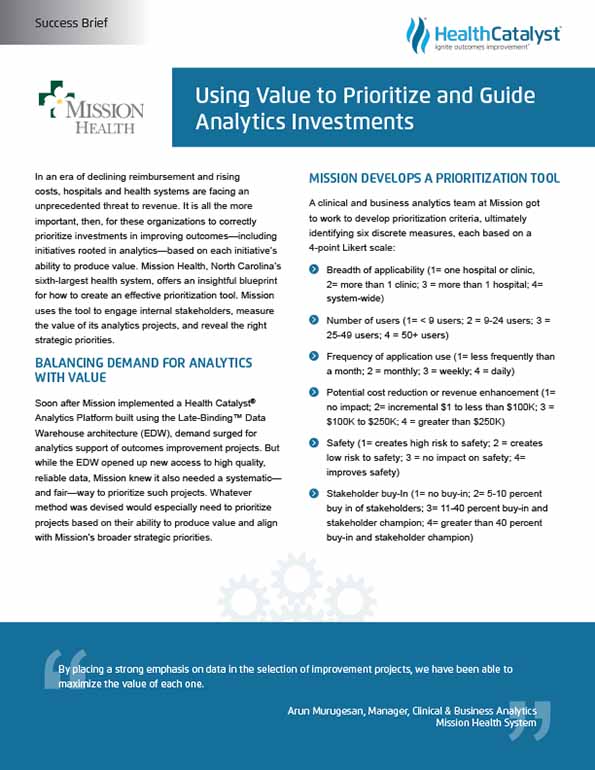Hospitals can enhance outcomes using analytics but potentially face resource limitations. Mission Health developed a prioritization tool to identify high-value projects aligned with the organization's priorities, ensuring effective use of resources. This approach also helped increase stakeholder engagement in improvement initiatives to enhance patient outcomes.
In an era of declining reimbursement and rising costs, hospitals and health systems are facing an unprecedented threat to revenue. It is all the more important, then, for these organizations to correctly prioritize investments in improving outcomes—including initiatives rooted in analytics—based on each initiative’s ability to produce value. Mission Health, North Carolina’s sixth-largest health system, offers an insightful blueprint for how to create an effective prioritization tool. Mission uses the tool to engage internal stakeholders, measure the value of its analytics projects, and reveal the right strategic priorities.
Soon after Mission implemented a Health Catalyst Analytics Platform built using the Late-Binding™ Data Warehouse architecture (EDW), demand surged for analytics support of outcomes improvement projects. But while the EDW opened up new access to high quality, reliable data, Mission knew it also needed a systematic—and fair—way to prioritize such projects. Whatever method was devised would especially need to prioritize projects based on their ability to produce value and align with Mission’s broader strategic priorities.
A clinical and business analytics team at Mission got to work to develop prioritization criteria, ultimately identifying six discrete measures, each based on a 4-point Likert scale:
These measures were then built into an Excel spreadsheet, with a drop-down menu for internal stakeholders to select the applicable response. Importantly, a weighting system is applied to the six measures and the Likert scale responses to assure the strongest possible alignment with organizational strategic goals.
Use of the prioritization tool is required for improvement project approval and support; however, consults from the clinical and business analytics team are available if needed to assure benefits are accurately stated. Indeed, this early consultation approach helps to maximize the likelihood of ultimate approval. It also enables the clinical and business analytics team to deal with potential internal stakeholder frustration or pushback by offering them support and encouragement for future approval, if not initially approved.
Proposed projects are reviewed every six months by the clinical and business analytics team, and subsequently presented to a steering committee consisting of senior leadership (for example, the CEO, CIO, CMO, VPs, and physician leaders) for ultimate approval. Each proposed outcomes improvement project is required to establish both financial and non-financial targets for the project. As such, approved projects are subject to retrospective review and comparison of targeted and actual results.
Mission’s goal to prioritize healthcare analytics investments to maximize value is delivering on all fronts. Mission’s internal stakeholders are bringing informed ideas to the table. Of the 55 projects that have been approved, an estimated 80 percent have met or exceeded their initial targets. Here are some of the impressive values achieved:
Because of the prioritization tool and early consult process, Mission has realized these values all the more quickly. An improvement process previously could take upwards of 90 days to launch—a wait that has essentially been eliminated.
“By placing a strong emphasis on data in the selection of improvement projects, we have been able to maximize the value of each one.”
– Arun Murugesan, Manager, Clinical & Business Analytics, Mission Health System
Mission Health continues to refine and improve the prioritization criteria and weighting based on analytics and continuous improvement processes. It’s also investigating migration of the tool from Excel into an analytics application. These and other efforts will be considered in support of internal stakeholders who are now more engaged than ever in driving outcomes improvement projects.


